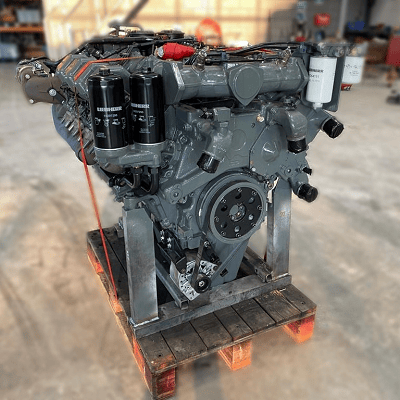The process of a dyno test on a Liebherr engine

When it comes to heavy machinery, reliability and power are paramount. Liebherr, a name synonymous with innovation and excellence in engineering, stands tall as a pioneer in the realm of heavy Equipment and machinery. From towering cranes to robust excavators, Liebherr’s engineering prowess extends to the heart of these machines. We delve into the world of dyno testing a Liebherr engine, uncovering the meticulous process behind unleashing the raw power concealed within.
The foundation of excellence
Before we embark on the journey of dyno testing, it’s crucial to understand the foundation upon which Liebherr engines are built. With decades of engineering expertise and commitment to quality, Liebherr engines are crafted to withstand the most demanding environment and deliver unparalleled performance. Each component is meticulously designed and rigorously tested to ensure reliability, efficiency and longevity.
The process
1 Preparation: The engine undergoes meticulous preparation before being mounted onto the dynamo meter. This includes ensuring all connections are secure, fluids are filled to the appropriate levels, and sensors are properly calibrated.
2 Mounting: The engine is carefully mounted onto the dynamometer, a specialized device designed to simulate real-world operating conditions. Precision is paramount during this step to ensure accurate results.
3 Initial checks: Once mounted, a series of initial checks are conducted to verify proper alignment, connection integrity, and functionality of all engine systems.
4 Warm-up: The engine is started and allowed to warm up to operating temperature. This ensures consistent results and minimizes the risk of damage during testing.
5 Baseline testing: With the engine warmed up , baseline tests are conducted to establish initial performance metrics. This includes measuring power output, torque, fuel consumption, and emissions at various RPM levels.
6 Load testing: The engine is subjected to progressively increasing loads to simulate different operating conditions, such as idle, partial load and full load. This allows engineers to assess performance across the entire operating range and identify any potential issues or optimization.
7 Data analysis: Throughout the testing process, data is continuously collected and analyzed in real-time. Advanced instrumentation and software are used to monitor performance metrics and identify trends or anomalies.
8 Optimazation: Based on the data analysis, adjustments may be made to optimize engine performance. This could involve fine-tuning fuel injection timing, adjusting air-fuel ratios, or optimize turbocharger boost pressure.
9 Validation: Once testing is complete, the results are meticulously reviewed and validated against predetermined criteria and specifications. Any deviations or anomalies are thoroughly investigated to ensure accuracy and reliability.
10 Reporting: Finally, a comprehensive report is generated detailing the results of the dyno testing, including performance metrics, observations, and any recommendations for further optimization or refinement.
The outcome of dyno testing
Dyno testing a Liebherr engine is more than just a routine procedure – it’s a testament to the unwavering commitment to excellence that defines Liebherr’s engineering philosophy. By subjecting their engines to rigorous testing and analysis, Liebherr ensures that each engine delivers the uncompromising performance, reliability, and efficiency that customers expect.
In conclusion, dyno testing a Liebherr engine is not just about measuring power output. It’s about unlocking the true potential of these remarkable engines and ensuring they exceed expectations in the most challenging environments imaginable.
Hot Melt Adhesive For Plastic Straw
First of all, straw hot melt adhesive is a kind of hot melt adhesive strip or particle, which is heated and melted by hot melt adhesive gun and sprayed or smeated on the surface of the object that needs to be bonded, waiting for the melt adhesive to cool and solidify to form a stable bond. The color and hardness of hot melt adhesive are different, and different types of hot melt adhesive can be selected according to your needs.
Then, the use of straw hot melt adhesive need to pay attention to some matters. First of all, you need to select the appropriate hot melt Glue Gun and hot melt glue strips or particles to ensure that they are suitable for the surface of the object that needs to be glued. Secondly, it is necessary to pay attention to the temperature and flow rate of hot melt adhesive, too high or too low temperature and flow rate will affect the bonding effect of hot melt adhesive. In addition, it is necessary to pay attention to the use environment and shelf life of hot melt adhesives to avoid affecting the quality and effect of hot melt adhesives.
Third, straw hot melt adhesive has a variety of advantages. Pipette hot melt adhesive has fast, efficient and stable bonding effect, which can achieve high quality sealing and fixing. At the same time, the straw hot melt adhesive has good water resistance, corrosion resistance, high temperature resistance and other properties, can be applied to a variety of environments and occasions. In addition, the straw hot melt adhesive also has the characteristics of simple operation, no pollution, economic and practical, which has brought a lot of convenience and advantages for production and manufacturing.
In addition, straw hot melt adhesive can also be used in a variety of fields and materials bonding and sealing. Straw hot melt adhesive can be used for bonding and sealing of paper, plastic, metal, ceramics and other materials, and can be applied to packaging, manufacturing, construction and other fields, with a wide range of application scenarios and market demand.
In short, straw hot melt adhesive is a fast, efficient, stable and other advantages of industrial hot melt adhesive, with a wide range of application scenarios and market demand. When using straw hot melt adhesive, it is necessary to pay attention to the selection of hot melt adhesive, the control of temperature and flow rate, so as to avoid affecting the quality and effect of hot melt adhesive.
Hot Melt Adhesive For Plastic Straw,Food Hot Melt Adhesive,Food Straws Hot Melt Adhesive,Straws Hot Melt Adhesive
Shenzhen Tongde New Materials Technology Co., Ltd. , https://www.tdhotmeltglue.com
![<?echo $_SERVER['SERVER_NAME'];?>](/template/twentyseventeen/skin/images/header.jpg)